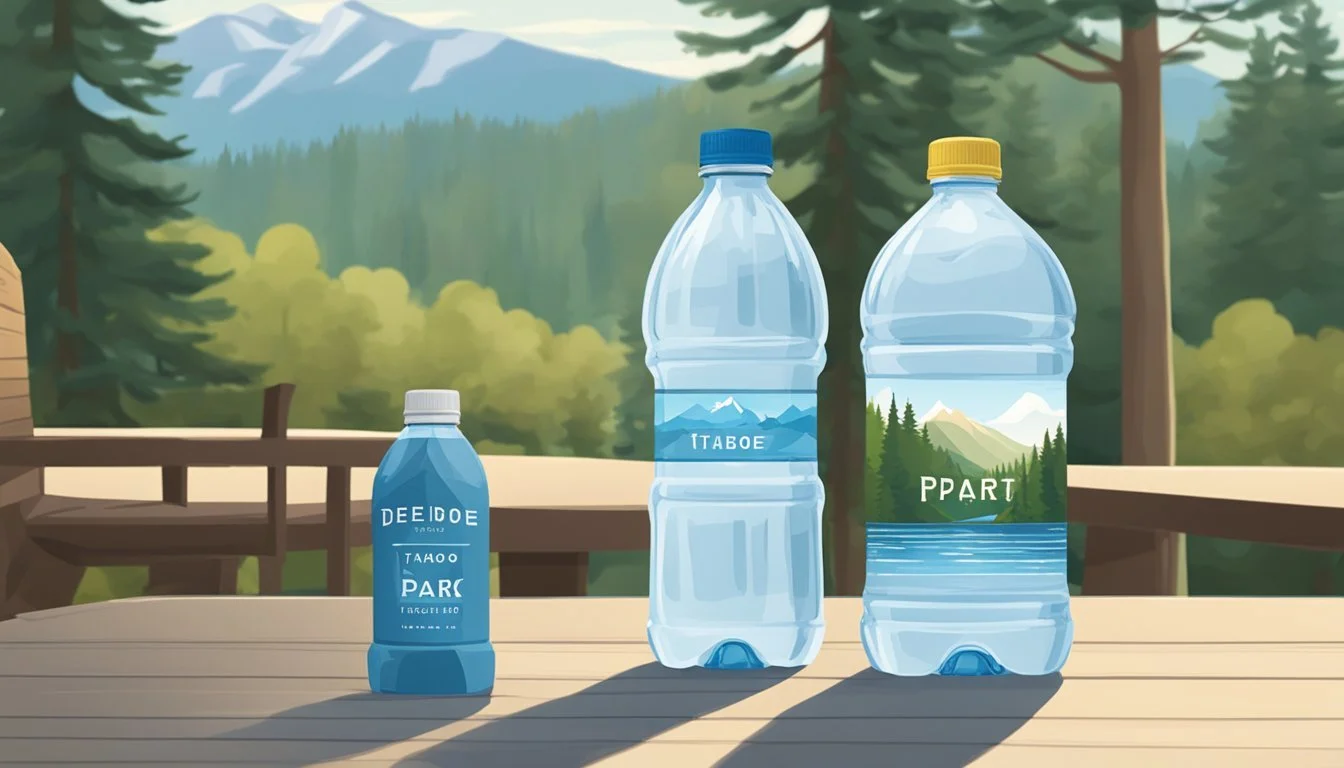Deer Park vs. Tahoe
Which Bottled Water is Better for Your Health?
Deer Park and Tahoe are two prominent bottled water brands often found on store shelves, each with its own distinct characteristics. Deer Park, sourced from natural springs along the Eastern Seaboard, prides itself on its crisp and clean taste. Tahoe, known for its purity, often boasts water sourced from the Sierra Nevada mountains, offering a refreshing and smooth experience.
When comparing the quality and taste of Deer Park and Tahoe, Tahoe generally stands out for its refreshing purity. Deer Park, while reliable and accessible, sometimes carries a slightly mineral-like tang that may not appeal to all palates. Tahoe's water, usually free of any noticeable aftertaste, often provides a more universally pleasing option for those seeking simple hydration.
Understanding the subtle differences between these two brands can help consumers make an informed choice based on personal preferences and hydration needs. Both brands ensure high standards of quality, but one's taste and texture might align more closely with what you seek in bottled water.
Background on Bottled Water Industry
The bottled water industry has grown rapidly over the past few decades. Key developments, major brands, and consumption patterns have all played vital roles in shaping this booming market.
Historical Development
The bottled water industry dates back to the 18th century when water was bottled for medicinal purposes. By the late 19th century, brands like Poland Spring emerged, expanding commercial sales. The late 20th century saw a surge in bottled water's popularity as consumers sought healthier beverage options.
Mass production and advancements in purification technology contributed to its growth. Brands like Evian and Fiji capitalized on the trend by marketing their water as pure and premium. This period also witnessed the rise of natural spring water brands like Deer Park.
Major Players and Brands
Several key brands dominate the bottled water market, each with unique selling points. Deer Park and Tahoe brand themselves as natural spring waters. Global players like Evian and Fiji position themselves in the premium segment, emphasizing their exotic sources.
Dasani and Aquafina, produced by Coca-Cola and PepsiCo respectively, rely on advanced purification processes. smartwater, another notable player, utilizes vapor distillation. The International Bottled Water Association plays a crucial role in industry regulation and standards.
Industry Trends and Consumption Patterns
The bottled water industry has witnessed remarkable growth, driven by increasing health consciousness and convenience. According to market research, bottled water sales grew by 73% between 2010 and 2020.
Consumers favor brands that offer perceived purity and convenience. Sustainability trends have led to increased demand for eco-friendly packaging. Single-serve bottles dominate the market, though there is growing interest in larger packaging for household use.
Emerging segments like flavored and enhanced water also contribute to diversified consumer choices. Understanding these trends is crucial for navigating the competitive landscape of the bottled water industry.
Understanding Water Sources
When comparing Deer Park and Tahoe bottled waters, the origins and quality of their water sources play a significant role. By understanding the distinctions between spring water and purified water, as well as the standards set by regulations and testing procedures, consumers can make informed choices.
Spring Water vs. Purified Water
Spring water is sourced from natural springs, where water flows to the surface of the earth. It contains natural minerals that imparts a distinct taste. Deer Park, for instance, sources its water from multiple springs across the Eastern Seaboard.
Purified water, like that in some brands including Tahoe, undergoes extensive treatment processes such as distillation, deionization, or reverse osmosis. These processes remove impurities and contaminants, resulting in crisp, clean water. Unlike spring water, the mineral content in purified water can be adjusted.
Natural Spring Water and Groundwater
Natural spring water comes from underground sources that naturally rise to the surface. Such sources are often protected from environmental pollutants, ensuring purity. Deer Park’s natural spring water is a typical example, with its water being drawn from protected sources.
Groundwater, on the other hand, is water located beneath the earth's surface, often in aquifers. While it can serve as a source for spring water, groundwater might require minimal treatment to meet bottled water standards. Groundwater sources are generally tested for microbial safety and quality before use.
Bottled Water Regulations and Source Testing
The FDA regulates bottled water in the United States, ensuring it meets strict safety standards. Both Deer Park and Tahoe must comply with these regulations, which include regular testing for contaminants such as bacteria and chemicals.
Both types of water sources are subjected to rigorous testing. This includes checks for pH levels, mineral content, and potential contaminants. The testing ensures that the water is safe for consumption and comparable to the quality of municipal tap water.
Compliance with FDA regulations and routine source testing ensures that whether from a spring or purified, the bottled water is safe and high quality, giving consumers confidence in their choices.
Health and Hydration
Understanding the health benefits of Deer Park and Tahoe bottled water includes looking at hydration, pH levels, minerals, and electrolytes.
Hydration and its Importance
Hydration is crucial for bodily functions. Both Deer Park and Tahoe effectively contribute to daily hydration needs. Deer Park, sourced from natural springs, provides hydration with a refreshing taste. Tahoe, also known for its natural purity, ensures reliable hydration. Both brands meet rigorous safety standards, making them safe hydration choices. Proper hydration helps maintain energy, support cognitive function, and regulate body temperature.
pH Levels and Body Balance
pH levels in bottled water can affect body balance. Deer Park water typically has a slightly acidic to neutral pH. Tahoe water often leans towards a neutral pH. Consuming water with balanced pH supports bodily functions and acid-base homeostasis. While both brands cater to hydration needs, those prioritizing pH balance might prefer Tahoe for its neutral pH.
Minerals and Electrolytes
Minerals and electrolytes are vital for health. Deer Park contains naturally occurring minerals like calcium and magnesium, which support bone health and muscle function. Tahoe water, similarly, offers essential minerals but may have different concentrations due to its unique source. Electrolytes in both brands help maintain nerve function and muscle contraction. Choosing between them can depend on individual mineral needs and taste preferences.
Water Quality and Safety
For those considering Deer Park and Tahoe bottled waters, understanding the quality and safety measures is essential. This section covers the main aspects, including quality assessment procedures, contaminants, and their potential impact on health and the environment.
Quality Assessment Procedures
Both Deer Park and Tahoe bottled water undergo rigorous quality assessment procedures. Deer Park sources its water from natural springs along the Eastern Seaboard of the United States, following strict testing protocols to ensure its purity. Each batch is tested for contaminants such as bacteria, heavy metals, and other impurities.
Tahoe, on the other hand, is known for its high standards in filtration and purification processes. They employ advanced technologies like reverse osmosis and UV treatment to eliminate any potential contaminants. Regular quality reports are published to keep consumers informed about the water's safety and purity levels.
Contaminants and Safety of Bottled Water
When discussing bottled water safety, the presence of contaminants is a primary concern. Deer Park has been found to contain minimal levels of PFAS chemicals, which are below the safety thresholds set by regulatory bodies such as the IBWA. This ensures that the water is safe for regular consumption.
Tahoe prides itself on offering water free from harmful contaminants. Their stringent testing processes identify and mitigate the presence of substances like microplastics and excessive mineral content. Both brands prioritize consumer safety by adhering to safety standards and conducting frequent quality checks.
Environmental Impact of Bottled Water
The environmental impact of bottled water is an important consideration. Deer Park promotes sustainability by using recyclable materials for its bottles and supporting water conservation initiatives. Conversely, Tahoe's environmental policies focus on reducing plastic waste through the use of biodegradable and reusable packaging.
Moreover, both brands actively participate in efforts to minimize their carbon footprint by optimizing their distribution processes and encouraging recycling among consumers. Efforts are made to ensure that the extraction and bottling processes cause minimal disruption to local ecosystems.
Each of these practices underscores their commitment to maintaining the balance between providing quality bottled water and protecting the environment.
Deer Park and Tahoe Brand Analysis
Deer Park and Tahoe both offer unique attributes concerning their company backgrounds, water sources, and treatment processes. This analysis dissects these aspects to provide a thorough comparison.
Company Profiles
Deer Park: Owned by Nestlé Waters, Deer Park is a well-established brand known for its loyalty to providing natural spring water. The brand highlights its long-standing history and commitment to environmental sustainability.
Tahoe: Tahoe, although less recognizable than Deer Park, markets itself as a brand dedicated to purity and freshness. It leverages its unique positioning to appeal to those seeking premium quality bottled water.
Source and Origination
Deer Park: Deer Park sources its water from multiple springs located along the Eastern Seaboard of the United States. These sources are primarily in Pennsylvania, Maryland, and Florida.
Tahoe: Tahoe's water originates from the Sierra Nevada Mountains, specifically the Tahoe Basin. This location is renowned for its pristine environment, promising a natural and unadulterated water source.
Filtration and Purification Methods
Deer Park: Utilizes a minimal filtration process to maintain its claim of natural spring water. The water undergoes standard procedures to remove large particulates but strives to retain its natural mineral balance.
Tahoe: Employs an advanced purification method that includes multi-stage filtration. This process involves initial sediment filters, carbon treatment, and UV light to ensure the water is free from contaminants while preserving its natural taste.
Comparison Table:
Brand Source Location Filtration Process Deer Park Eastern Seaboard (Multiple Springs) Minimal Filtration, retains minerals Tahoe Sierra Nevada Mountains (Tahoe Basin) Multi-stage Filtration, advanced purification
Taste and Consumer Preference
Deer Park and Tahoe offer distinct experiences based on their taste and pH levels. Understanding the role of pH can clarify the nuances in their flavor profiles.
The Role of pH in Taste
The pH level of bottled water significantly impacts its taste. Deer Park water generally has a pH range of 6.5 to 8.0, situating it within the neutral to slightly alkaline spectrum. This range is often perceived as refreshing and clean.
Tahoe water, in contrast, typically exhibits a pH level of around 8.4, making it more alkaline. Higher pH levels can result in a smoother taste, appealing to those preferring less acidity in their water. The difference in pH levels contributes to the unique flavor profiles each brand offers.
Flavor Profiles
Deer Park prides itself on its crisp and clean taste, attributed to its natural spring sources along the Eastern Seaboard. Consumers often describe the water as having a pure and refreshing quality, free from any detectable aftertaste.
Tahoe, with its higher pH level, is often noted for its smooth and slightly sweet flavor profile. This can give the water a more velvety texture, which some consumers find more appealing. The distinct mineral composition of Tahoe contributes to its unique taste.
Understanding these factors can guide consumers in selecting the brand that best matches their taste preferences.
Comparative Analysis
Examining Price and Accessibility, Consumer Reviews and Reputation, and Health Benefits and Marketing Claims reveals significant differences between Deer Park and Tahoe bottled water brands.
Price and Accessibility
Deer Park is widely available across the eastern United States and can be found in many grocery stores and convenience marts. Its pricing is competitive, often making it a popular choice for consumers seeking affordability.
Tahoe, on the other hand, tends to be less accessible geographically, primarily available in the western regions. Its price point is often higher, reflecting its premium market positioning. Consumers may find Tahoe in specialized stores or through online retailers, which may add convenience but also influence the overall cost.
Consumer Reviews and Reputation
Deer Park has built a strong reputation over the years, known for its crisp taste and natural spring sources. Consumer reviews frequently highlight its consistent quality and availability. Deer Park’s long-standing market presence since after the Civil War adds to its credibility.
Tahoe enjoys a reputation for purity and premium quality. Reviews often commend its clean taste and the brand’s commitment to environmental sustainability. While not as widespread as Deer Park, Tahoe’s niche appeal in the premium segment garners loyal customers who prioritize quality over convenience.
Health Benefits and Marketing Claims
Deer Park markets itself as 100% natural spring water, emphasizing purity and a neutral pH balance, typically between 6.5 to 8.5. The brand focuses on its natural origins and minimal processing, appealing to health-conscious consumers.
Tahoe emphasizes its water's natural sourcing from pristine environments and often markets the health benefits associated with high mineral content and pH balance. Tahoe positions itself as a premium health-focused brand, leveraging claims of superior hydration and wellness benefits.
Both brands highlight their commitment to quality and health but target slightly different consumer bases. Deer Park appeals to those seeking reliable, accessible bottled water, while Tahoe attracts those looking for premium quality and holistic health benefits.
Sustainability and Environmental Considerations
When comparing Deer Park and Tahoe bottled water, sustainability and environmental considerations are essential. This section explores the environmental impact of bottled water production and the efforts made by each brand to reduce their carbon footprint.
Bottled Water and Environmental Sustainability
Bottled water production has significant environmental impacts, including depletion of natural resources and plastic waste. Deer Park sources its water from natural springs across the Eastern Seaboard, which requires managing water resources responsibly. Tahoe, known for its pristine water from Lake Tahoe, also faces challenges in maintaining the balance of natural resource extraction.
Both brands package their water in plastic bottles, contributing to plastic pollution. Deer Park and Tahoe must address issues like the recycling rate of their bottles and the environmental cost of plastic production. Utilizing recycled materials and encouraging proper disposal are crucial steps for minimizing their environmental footprint.
Brand Initiatives and Carbon Footprint
Deer Park has taken steps to mitigate its environmental impact through various initiatives. The brand focuses on using lighter plastic bottles, which reduces the amount of plastic required for each bottle. Deer Park is part of BlueTriton Brands, which aims to achieve carbon neutrality by optimizing energy use and minimizing emissions during their production processes.
Tahoe also emphasizes sustainability, implementing measures to protect Lake Tahoe's delicate ecosystem. The brand uses bottles made from recycled PET and supports local conservation efforts. Tahoe actively pursues partnerships that focus on reducing carbon emissions and preserving natural water sources.
Both brands' initiatives show a commitment to sustainability and reducing their environmental impact. Balancing consumer demand for bottled water with eco-friendly practices remains a priority for both Deer Park and Tahoe.
Conclusion
Deer Park and Tahoe bottled waters each have distinct characteristics that cater to different consumer preferences.
Deer Park is known for being sourced from the Eastern seaboard, presenting itself as 100% natural spring water. Its pH generally ranges from 6.3 to 8.7. This range is close to pure water, appealing to those who prefer a neutral to slightly acidic taste.
In contrast, Tahoe focuses on being a premier bottled water brand with its source often marketed as pure and pristine. Though specific pH values are not commonly advertised, Tahoe is often chosen for its reputed clean and refreshing taste.
When choosing between Deer Park and Tahoe, consumers should consider their priorities, such as taste, pH levels, and perceived purity.
Comparison Table:
Attribute Deer Park Tahoe Source Eastern seaboard springs Pristine locations pH Level 6.3 - 8.7 Not commonly listed Marketing Focus Natural spring water Pure, clean taste Taste Profile Neutral to slightly acidic Refreshing, clean
This guide helps consumers make an informed decision based on their individual preferences and requirements.
More About Deer Park
Deer Park vs Cascade Mountain: Which Bottled Water is Better?
Deer Park vs Hawaii Volcanic: Which Bottled Water is Better?
Deer Park vs Hawaiian Springs: Which Bottled Water is Better?
Deer Park vs Icelandic Glacial: Which Bottled Water is Better?
Deer Park vs Kirkland Signature: Which Bottled Water is Better?
Deer Park vs Mountain Valley Spring Water: Which Bottled Water is Better?
Deer Park vs Nestle Pure Life: Which Bottled Water is Better?
Deer Park vs Richard's Rainwater: Which Bottled Water is Better?
Deer Park vs Solan de Cabras: Which Bottled Water is Better?
Deer Park vs Talking Rain AQA: Which Bottled Water is Better?
Deer Park vs Whole Foods 365: Which Bottled Water is Better?
Deer Park vs Whole Foods Italian Still Mineral water: Which Bottled Water is Better?








